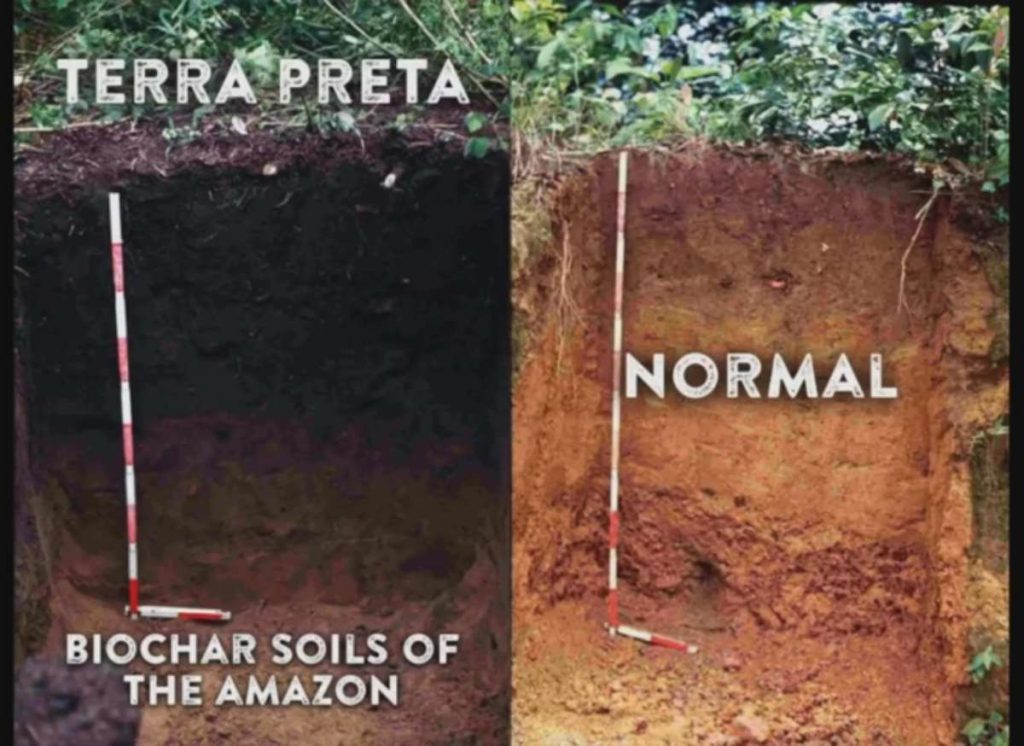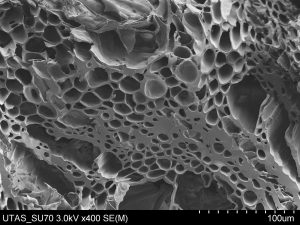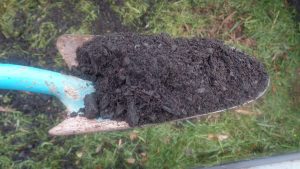In recent years there has been a lot of talk about biochar and terra preta from the Amazon being the answer to sustainable growing prayers. I’m trying to separate the truth from the hype that surrounds biochar.
July 2019 This page has been updated in the light of significant new information and recent scientific studies of biochar.
Biochar – Terra Preta
What is Biochar / Terra Preta?
Terra Preta is Portuguese for ‘black earth‘ and refers to areas of dark, fertile soil discovered in the Amazon basin. The reason for the soil fertility, in an area where the soils are noted for their lack of fertility, is attributed to the use of biochar by the civilisation that thrived there some 2,500 years ago.
Biochar is the name given to charcoal made from plant materials and wood in the same way as ordinary charcoal is made with controlled burning or roasting in the absence of oxygen, known as pyrolysis. This is usually ground into small particles.
The charcoal is then inoculated with microbial mixtures and nutrients. This is known as activating or charging the biochar.
Benefits of Biochar
The enthusiastic advocates claim that adding biochar to soil will:
- Increase soil fertility and nutrient availability producing better crops
- Increase the microbial flora and fauna of the soil
- Stabilise soils and after using for a number of years or adding a sufficient amount, produce a permanent change in the soil as with the fertile Amazonian Terra Preta black earth.
- Lock up carbon in the soil, reducing CO2 in the atmosphere and mitigating the climate change problem
There is no doubt that the Terra Preta of the Amazon exists and is very fertile but exactly how the pre-historic inhabitants achieved this is not known. It’s possible that natural, local processes took part. Terra Preta is associated with shards of pottery and other remains that that imply the charcoal was thrown into a midden. That certainly would have been rich in microbes. Some of the most enthusiastic advocates and studies showing very good results seem to be in tropical or semi-tropical climates which would suggest climate may be a factor.
Biochar Potentially Harmful?
Biochar in temperate climates such as Europe and the UK may well react differently to the tropics and a few studies have indicated that biochar, far from being beneficial may actually be harmful in the short term. This is most likely due to using uncharged biochar. That is ‘raw’ biochar / crushed charcoal. We now know that biochar needs to be inoculated with nutrients and microbes to work as advertised, that is activated or charged.
Having said that, the bulk of studies are promising and showing very positive results. We’re still researching biochar and seeking to understand the factors that influence it (see below).
Acidity Levels of Biochar (Effect on pH)
The pH of charcoal is generally very high, 8.4 having been measured. This is an extremely alkaline product and whilst useful to sweeten acid soils would make naturally alkaline soils too alkaline for many plants. Generally vegetable crops like a pH of around 6.5 to 7.2 at most. Adding large quantities of biochar could even make acid soils too alkali to support crops in theory.
Using smaller quantities of biochar on an acid soil would certainly be beneficial in that it would increase the pH in a similar way to adding lime to soil.
Microbial Action & Biochar
It seems the micro-pores in biochar provide a home for a starting culture of beneficial bacteria and fungi. Mycorrhizal fungi are proven to work in symbiosis with plant roots. The fungi supply nutrients to the plants and receive sugars from the plants in return.
Adding ground charcoal to the soil will darken it in the same way that chimney soot was traditionally added to soil in the days when every house had an open fire. Darkening the soil will cause it to absorb more sunlight and warm up earlier in the spring and remain warm longer in the autumn which will increase the microbial population. Warmer soil obviously benefits plant growth as well.
However, biochars work best as larger particles rather than powders so there’s far more going on than just soil warming.
Stabilising the Soil – How Long does Biochar Last?
Laboratory tests and data from Institut für Agrarrelevante Klimaforschung (Institute of Agricultural Relevant Climate Research) in Germany suggest that the 1,000 year or even permanent stability benefits claim is over-stated and the actual benefits range from 10 to 100 years which is of the same order as compost.
However, Terra Preta is known to be 2,500 years old so my bet would be that the benefits of biochar will last for millennia rather than decades.
Effects on CO2 levels
Certainly biochar locks up carbon that would be released quickly by normal burning or slowly by woody materials rotting down. In natural eco-systems, however, the CO2 released by rotting wood would be taken in by the growth of new plants and trees.
Another German study in 2009 concluded that converting 10% of all their waste plant materials to biochar would actually only sequester 1.6% of their carbon. Whilst this may seem a small amount, large scale use of biochar does have the capacity to take out significant amounts of atmospheric carbon dioxide.
Effects on plant growth of Biochar
Not all the studies on biochar are positive but generally they show around a 20% gain in crop yield when compared with untreated soil. Some studies into the effects of biochar on plant growth have shown negative effects or no effect when compared with untreated soils. Most worrying are some studies showing reduced numbers of earthworms in soil with biochar.
Some reports are that it gave great benefits on poor and degraded soils but less so on soils already rich in nutrients and organic matter.
Factors that may Affect Biochar Tests
The differences in results reported isn’t really surprising, there are so many variables that can be affecting the results, including:
- How the biochar was made.
- What temperature it was made at.
- Particle size of the biochar
- How it was charged or if it was charged at all
- Soil type (in the UK there are 22 recognised soil types!)
- Nutrient levels in the soil.
- Organic matter / humus content of the soil
- Climate & weather conditions.
- Amount of biochar added
- If the biochar was added in one application or over a period of time
- Additional nutrients added with the biochar
- Application method (surface spread or mixed into the topsoil)
Charging (Activating) Biochar
The general consensus is that to be immediately effective, biochar needs to be charged or activated. It’s like a sponge and will absorb nutrients, microbes and fungi. Just adding freshly made biochar into the soil will actually deplete nutrients that are being sucked into the sponge. Hence the poor to negative results of some studies.
Cost of Biochar
Biochar is not cheap to buy. The price, weight for weight, is comparable with premium grade sustainably home produced barbecue charcoal. It’s far more expensive than the sort of charcoal you’ll find on a garage forecourt. That garage charcoal is most likely imported, the charcoal made from tropical hardwood (possibly illegally felled) and sometimes with chemical accelerators to help it burn. Definitely not the material to use for biochar!
However, since the final particle size wanted for biochar is quite small (typically less then 10 mm), it could be made using brash wood – that is the tops and small-diameter branchwood left lying on the ground after the merchantable wood has been extracted (A – Z of tree terms: A companion to British arboriculture)
Brash wood is too small to be useful for barbecue charcoal. Making use of a waste product could be the way to produce biochar cheaply and even more sustainably.
Although biochar is costly, unlike a fertiliser or compost, once applied it remains in the soil permanently.
Biochar My Conclusions
I now think that we’re well past the ‘does biochar work?’ stage. There’s plenty of hard evidence it does work but we still need to understand it better. Once we know more about what causes the observed results, we’ll be able to predict and advise under what conditions to use use it etc.
Just running trials on the multiple suggested charging methods, especially multi-year trials would be immensely useful. There must be some bio-scientist out there looking for a good subject to gain a doctorate!
With potential to sequester carbon into the soil it is a way to reduce carbon dioxide in the atmosphere whilst regenerating degraded soil so it produces more crops with less inputs, it is certainly well worth more study.
Biochar for Allotments & Gardens
For now, I think it is at least well-worth garden scale growers trialling biochar and seeing what the results are in their situation. If proven to benefit in your situation, then apply it to all the plot. You can buy biochar or a biochar / compost soil amendment and try it on one bed. Then grow the same crop on a treated and untreated bed to compare. Alternatively you could make some biochar yourself and try that.
Do be careful not to overdo it initially, small is beautiful. Biochar is a permanent soil amendment – once you add biochar, it cannot be removed. Start with something like 0.5Kg per square metre. You can incrementally add more annually if you wish.
Further Information on Biochar
Biochar: a gardener’s primer. Washington State University Extension Fact Sheet
A quantitative review of the effects of biochar application to soils on crop productivity using meta-analysis – S. Jeffery, F.G.A. Verheijena, M. van der Veldea, A.C. Bastosc
Biochar organic fertilizers from natural resources as substitute for mineral fertilizers – Bruno Glaser, Martin Luther University; Hans-Peter Schmidt, Ithaka Institute; Katja Wiedner, EUROFINS GERMANY
Soilfixer Web Site – a wealth of information on biochar including plant trials, sells biochar and biochar related products.








